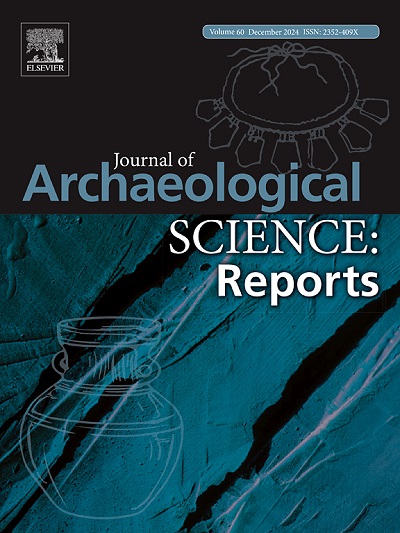玻璃制品上的蓝色装饰:中世纪晚期至近代早期葡萄牙的起源和意义
IF 1.5
2区 历史学
0 ARCHAEOLOGY
引用次数: 0
摘要
中世纪晚期和近代早期葡萄牙的考古背景揭示了一些使用蓝线的无色物体。通常与圆柱形玻璃杯和高脚杯基座有关,这种装饰可以在几个特征中找到:一条或多条线水平或螺旋应用,褶边形成彩花或蓝线与罗纹装饰相结合。这些物品的存在揭示了与上层社会的联系,因为它们被认为是奢侈的,可以被识别为进口的,这引发了对它们来源的质疑。本研究调查了来自里斯本、阿尔马达和Setúbal五个葡萄牙考古遗址的20件装饰有蓝色装饰的玻璃制品,这些文物可追溯到14至16世纪。通过微粒子诱导x射线发射(μ-PIXE)和激光烧蚀电感耦合等离子体质谱(LA-ICP-MS)相结合的方法,对玻璃的化学成分进行了检测。风格调查和分析技术揭示了这种类型的装饰物品所使用的原材料在古代和现代人工制品之间的差异,表明了社会品味和所使用的原材料的变化,从而表明了生产地点的变化。经分析的碎片的化学成分属于钠硅石灰类,这为它们的起源提供了线索,并引发了一场关于这些物品是进口还是本地生产的争论。这种跨学科的方法结合了考古发现,风格分析和化学分析,提供了对中世纪和文艺复兴时期欧洲玻璃生产的文化和技术动态的理解。本文章由计算机程序翻译,如有差异,请以英文原文为准。
Blue decoration on glass Objects: Unravelling origins and Significance in late medieval – Early modern Portugal
Late medieval and Early modern Portuguese archaeological contexts have brought to light several colourless objects with blue thread application. Usually related to cylindrical glasses and pedestal goblets, this decoration can be found in several features: one or more lines applied horizontally or in a spiral, frills forming festoons or blue lines combined with a ribbed decoration. The presence of these objects reveals a connection with the upper strata of society, as they were considered luxurious and could be identified as imported, raising questions about their provenance. This study examines 20 glass objects adorned with blue decoration from five Portuguese archaeological sites in Lisbon, Almada, and Setúbal, dating from the 14th to 16th centuries. Through a combination of micro particle-induced X-ray emission (μ-PIXE) and inductively coupled plasma mass spectrometry with laser ablation (LA-ICP-MS), the chemical composition of the glass was examined. Stylistic investigations and analytical techniques shed light on how the raw materials used in objects with this type of decoration differ between older and more recent artefacts, indicating changes in society’s taste and the raw materials used, hence the place of production. The chemical composition of the analysed fragments, which falls within the soda-silica-lime group, gives clues to their origin and leads to a debate about whether these objects are imported or locally produced. This interdisciplinary approach combining archaeological findings, stylistic analysis and chemical analysis, offers an understanding of the cultural and technological dynamics that shaped glass production in medieval and Renaissance Europe.
求助全文
通过发布文献求助,成功后即可免费获取论文全文。
去求助
来源期刊

Journal of Archaeological Science-Reports
ARCHAEOLOGY-
CiteScore
3.10
自引率
12.50%
发文量
405
期刊介绍:
Journal of Archaeological Science: Reports is aimed at archaeologists and scientists engaged with the application of scientific techniques and methodologies to all areas of archaeology. The journal focuses on the results of the application of scientific methods to archaeological problems and debates. It will provide a forum for reviews and scientific debate of issues in scientific archaeology and their impact in the wider subject. Journal of Archaeological Science: Reports will publish papers of excellent archaeological science, with regional or wider interest. This will include case studies, reviews and short papers where an established scientific technique sheds light on archaeological questions and debates.
 求助内容:
求助内容: 应助结果提醒方式:
应助结果提醒方式:


